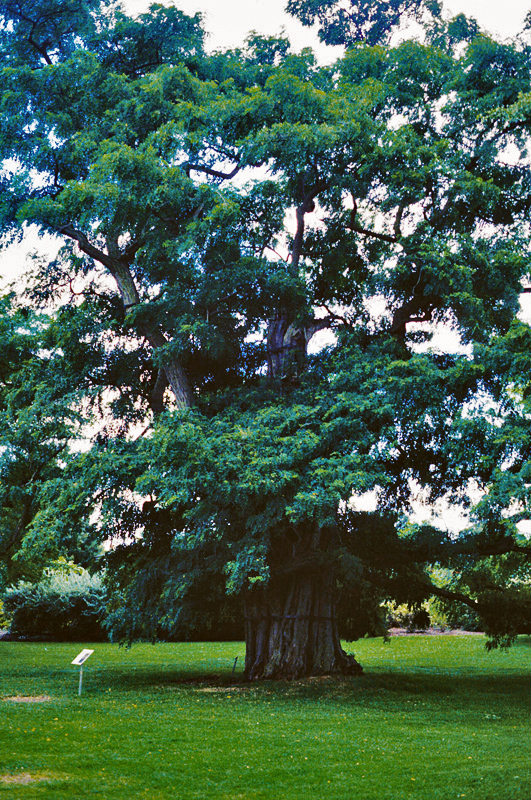
Woody > Quercus > Quercus castaneafolia > Quercus castaneafolia
Quercus castaneafolia
Chestnut-leaved Oak
Origin: Mountains of Caucasus and Iran. Introduced into cultivation in England in 1846.

"
Oaks are a classic, majestic group of trees, and the Chestnut-leaved Oak species is one of the most stately. Its low branches grow on a very stout trunk, which presents a marvelously full-crowned, stately tree while the attractive leaves look like a hybrid between Beech and the typical Oaks. It is a great accent for parks, estates and grand gardens. In the lush mountain forests of the Caucasus and Northern Iran next to the Caspian Sea, this species is an important part of the old-growth forest and is a food source to many animals. It is rarely seen outside of its native range and therefore valued as a rare landscape tree, it is thus surprising that more plant enthusiasts who have the space for such a specimen have not taken up its cause by growing this spectacular tree.
Michael Pascoe, NDP., ODH., CLT., MSc. (Plant Conservation)
"
| Family |
| Fagaceae |
| Genus |
| Quercus |
| Species |
| castaneafolia |
| Category |
| Woody |
| Type |
| Tree (deciduous) |
| USDA Hardiness Zone |
| 7a - 10a |
| Canadian Hardiness Zone |
| 8 - 11 |
| RHS Hardiness Zone |
| H6 |
| Temperature (°C) |
| -15 |
| Temperature (°F) |
| 5 |
| Height |
| 30 - 50 m |
| Spread |
| 30 - 35 m |
| General Description |
| A large deciduous tree with slightly dark green, shiny leaves with pronounced teeth, a full rounded crown, and pinkish-coloured catkins that produce mossy acorns that have a distinct orange flushing at one end. |
| Landscape |
| The acorns can be a food source for jays, squirrels and other wildlife. The tree is an excellent landscape specimen, wherever there is room for it to reach its distinguished, robust stature. |
| Cultivation |
| Grow in a well-drained, pH neutral loamy to sandy soil in full sun, however it does tolerate slight shade. It is somewhat urban tolerant, though it does not do well near busy streets or large structures where the soil reservoir may be poor and limited; parks and large gardens are best. |
| Shape |
| Large branches descend quite low on the trunk forming a spread to match its height. It has a masterfully rounded crown. |
| Growth |
| Fast |
| ID Characteristic |
| It has a large full crown with stout, straight branches. Leaf appearance is somewhere between Beech and typical Oak leaves, and blade-like with obvious prominent teeth. The bark is smooth, black, with whitish lenticels on young bark, and twigs that seem to resemble the native Pin Cherry (Prunus pensylvanica). These three traits combined should assist in the identification of Q. castaneifolia. Additionally, the large robust stature should distinguish it from the closely-related Lebanon Oak (Q. libani). |
| Pests |
| Insect pests may be Oak processionary moth (Thaumetopoea processionea), galls formed by gall wasps, or wood-boring beetles. Oak wilt, which is a fungus similar to Dutch Elm disease may affect the tree. |
| Habitat |
| Rich moist mountainous forests with well-drained, neutral soils. |
| Bark/Stem Description |
| Newly formed twigs are hairy and soft. Immature bark is black and smooth, with whitish lenticels. Aged bark, lightens to a dark grey, develops furrows at times, with orange-ish hues and even fissures. |
| Flower/Leaf Bud Description |
| The buds are about 2 cm long and conical shaped. |
| Leaf Description |
| Slightly dark green and shiny leaves that first become a dazzling bronze in autumn, then finally brown before abscising. They are not quite the expected shape of an Oak tree. Elliptic, dentate, pinnate, simple, alternate leaves 20 cm long. Lacking true lobes, the teeth are pronounced and pointed. Underside is somewhat hairy. The leaves are poisonous to horses, cattle, goats and sheep if eaten in large quantities, because of their tannic acid. |
| Flower Description |
| Its flowers are wind pollinated catkins. Male and female parts develop on separate structures but appear at the same time with a dull pinkish colour. |
| Fruit Description |
| Its acorns can be 2.5 cm wide by 3.5 cm long. They are a typical green, with a dab of orange on the base and a mossy cap. They take two years to mature. The acorns are also, in large quantities, poisonous to horses, cattle, goats and sheep. |
| Colour Description |
| Slightly dark green and shiny leaves. Catkins are dull pinkish in colour. Acorns are a typical green, though with a dab of orange on the base. |
| Texture Description |
| The leaves are very smooth, and the bark relatively smooth when young. Older bark becomes ridged and splits. Acorns are partly smooth, partly scaly or mossy. |
| Notable Specimens |
| Royal Botanic Gardens Kew, London, England. |
| Ethnobotanical Uses (Disclaimer) |
| A forestry and ornamental species. |
